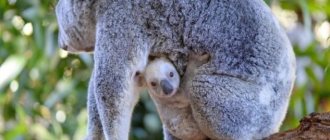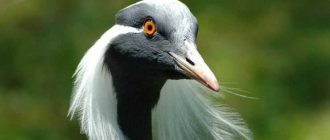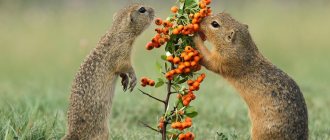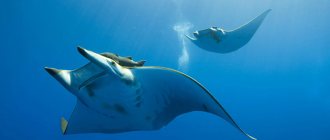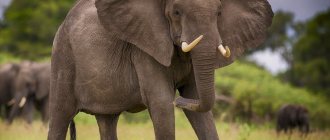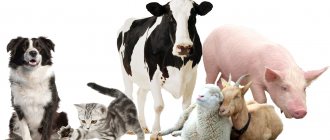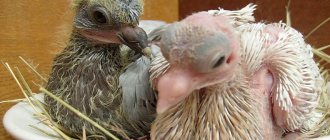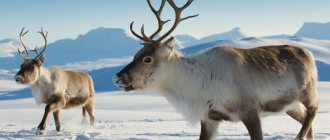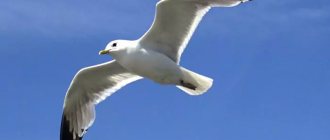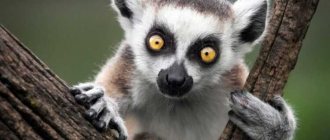Marsupials are mammals that give birth to premature offspring . Marsupial cubs are born at an early stage of development and further develop inside a special bursa of the mother's skin. Most marsupials live in Australia, with the exception of opossums, which are native to America. For millions of years Australia was isolated from the rest of the world. On other continents, marsupials gave way to placentals (mammals whose young fully develop in the womb) in the struggle for food and living space. Therefore, all of them, with the exception of possums, became extinct. But in Australia, marsupials had no rivals. The range of marsupials includes more than 250 species .
Baby marsupials are tiny when born; they are blind and hairless. Their limbs are underdeveloped, but the babies crawl along the mother’s fur to her nipples. After a few months, the cubs leave the pouch, but may return to roost there until they reach one year of age. Marsupials eat plant and animal foods.
Carnivores are a number of small carnivorous marsupials that include spotted marsupials, narrow-footed marsupials, numbats, and Tasmanian devils.
Marsupial mole
The marsupial mole is a marsupial animal very similar to ordinary moles in appearance and habits. These creatures dig tunnels underground, hunting insects and worms. Females have pouches that open backwards and only two nipples (meaning they can only give birth to two young at a time).
Two-incisor marsupials are a group of marsupials that include kangaroos, wallabies, gliders, koalas and wombats. They have two large front teeth on the lower jaw. The second and third toes of the hind paws of these animals are fused. They are predominantly herbivores .
https://youtu.be/https://www.youtube.com/watch?v=XZp_bH38nVQ
_
Lifestyle
Among marsupials there are both terrestrial and arboreal lifestyles, and the water possum has adapted to life in the water. Most are nocturnal animals.
Koala is a marsupial adapted to an arboreal lifestyle.
Diet
Among marsupials there are herbivorous, predatory and omnivorous species. Some people prefer only one type of food. For example, the proboscis-headed cuscus specializes in nectar and pollen. Others, such as four-eyed opossums, are very picky eaters. Their diet includes fruits, earthworms, insects and small vertebrates.
Social life
Four types of social organization of marsupials can be distinguished. In the first case, the structural unit is an individual whose area partially overlaps with several other areas. Males have large ranges that include those of several females, and mating is promiscuous. This is how small opossums and the proboscis possum live.
In the second type, the structural unit is also an individual, but with limited overlap of areas. The male's area overlaps with the areas of 1-2 females, with whom only he can mate. This type of social organization is characteristic of leaf-eating tree species.
The third type is family associations that share a common, often protected, territory among themselves. Groups may consist of a monogamous couple and their offspring or a dominant male, several adult females and young animals. Marsupial flying squirrels and some possums live in groups.
The fourth type are families of large kangaroos. In this social organization, the structural unit is a group of heterosexual individuals. Mating in such groups is promiscuous, and access to females is based on the size and dominance of the males.
Communication
In the communication of marsupials, the main role belongs to hearing and smell. Thus, arboreal species use sound signals to communicate over distances of up to several hundred meters. Some, such as small gliders, may chirp or squeak, while others, such as the koala, may roar.
Scent communication is carried out by passively leaving urine and excrement, and small species actively mark using the secretions of the skin glands.
Since marsupials are mostly active at night, vision is not of great importance for them.
How long do marsupials live?
The lifespan of a kangaroo in the wild is about 25 years. Small marsupials live shorter lives than large species. The shortest age of all is some species of predators, which die at the age of 12 months. The exception is the mountain cuscus, which lives longer than all small mammals: a female in nature can live more than 11 years.
Koala
photo source
The koala lives in trees and feeds on eucalyptus leaves and shoots; has a large nose and ears. With the help of tenacious paws, koalas deftly climb trees, while the cubs hold on to their mother’s back. Inhabits eucalyptus forests in the southern and south-eastern regions of Australia. Solitary animal, but male and female territorial ranges may overlap.
Sense organs
Different orders of mammals have characteristics of sensory organs. Inhabitants of open spaces have more developed vision than other mammals; nocturnal and twilight animals, as well as animals living in ponds or forest bushes, have well-developed senses of smell and hearing.
Vision
Animals that live in open spaces and lead a predominantly diurnal lifestyle perceive most information through the visual channel.
Inhabitants of forests and grassy areas have less acute vision, and in animals living in burrows, their vision ceases to function at all, and their eyes become overgrown with skin.
The eyes of mammals are located either on the sides of the head, thereby providing an almost all-round view, or in front, creating a wide field of binocular vision. The first option for the location of the eyes is more common in ungulates and rodents, which need to beware of attacks from predators. The second type of eye arrangement is more common in primates, which need to clearly determine the distance between trees to jump, and in predators, which must clearly determine the distance to the prey.
Hearing
Hearing and the ability to make sounds play an important role in the lives of animals. With the help of sounds, animals obtain food, learn about danger, and communicate with cubs and other representatives of their species.
The mammalian hearing organ is represented by three sections: the outer, middle and inner ear.
The outer ear is a specialized biological antenna-filter with which the animal picks up important noises and attenuates extraneous ones. It consists of the auricle and the external auditory canal.
Smell
The sense of smell in mammals is much more developed than in other representatives of the animal world. This is due to the anatomy of the olfactory organs. Chemoreceptors have a high resolution ability, thanks to which mammals can distinguish specific odors, as well as groups of odors.
Different orders have different levels of development of the sense of smell. Most predators, artiodactyls, and marsupials are superior to other representatives in this regard. They use this ability to search for food and navigate in space. In primates, on the contrary, the sense of smell is much less developed.
Kangaroo
photo source
Kangaroos live in Australia, Tasmania, New Guinea and the Bismarck Archipelago. They live in groups (herds) on open grassy plains. Today there are about 50 different species. The kangaroo moves by hopping on its long hind legs. All of them have fairly short forelimbs and strong hind limbs, and also - almost all species - a long powerful tail, which can reach a meter in length and serves as a balancer and additional support for the kangaroo. Females have a pouch on their abdomen in which the young develop. Kangaroo pregnancy lasts only 30-40 days. The baby is born the size of a human thumb. After this, it immediately moves into the mother’s pouch and firmly attaches itself to one of the nipples. The little kangaroo goes outside for the first time only after a few months.
Subclass Characteristics
The list of marsupials will be small. Scientists suggest that they were common in the Mesozoic, but were gradually replaced by placental animals. It is possible that the division occurred during the Jurassic period. The oldest fossils were found in the following places:
- Liaoning Province;
- northeast China;
- western North America.
Marsupials were common in South America, but after the migration of animals from the Northern continent, almost all became extinct. Only the possums survived.
In Australia, populations of many species have survived, but they have been negatively affected by human activities. Some scientists suggest that many species became extinct due to drought and the inability to compete with introduced animal species.
Representatives of marsupials have several features. The most important thing is raising the cubs in a special pocket on the stomach. The offspring is born prematurely and therefore needs special conditions. Another feature is that the cubs cannot suckle milk themselves. They only attach to the nipple, and the milk itself is injected into their mouth.
Orders of marsupials occupy different ecological niches:
- moles lead an underground lifestyle;
- koalas and possums can move on the ground;
- The water possum leads a semi-aquatic lifestyle.
The size of marsupials depends on the species. For example, mice barely exceed 10 cm in length, while kangaroos reach 3 meters. Based on the type of nutrition, we can distinguish herbivores, insectivores and predatory animals.
Some interesting facts about marsupials
The body sizes of marsupials range from a few centimeters to 1.5 meters. The smallest marsupial on Earth is the long-tailed marsupial mouse . The length of its body is from 80 to 100 mm, its tail - from 180 to 210 mm. The large red kangaroo is considered the largest marsupial animal .
Adult kangaroos can reach 2 m in height. A baby giant kangaroo remains in its mother's pouch for about 235 days. Tags Wild animal world Animals of Australia Unusual animals Marsupials
Biological significance of mammals
The importance of mammals in the ecosystem is due to the great diversity of species and the complexity of their behavior. In addition, animals of this class inhabit all natural zones, regardless of climatic conditions: walruses and seals inhabit the extremely cold continent and are a large link in the food chain there; artiodactyl zebras live on the hottest continent of the planet and play a similar role.
So, the role of mammals in natural systems:
- They are large links in the food chain. Representatives of some orders are food for representatives of other orders of mammals.
- Herbivores influence the flora by destroying some plants while spreading others by consuming and then excreting their indigestible particles. Most often this is done by various representatives of the rodent order.
- They have a beneficial effect on the soil: moles and shrews loosen the soil, thereby enriching it with oxygen. In addition, the droppings of all animals make the soil more fertile.
- Representatives of the order insectivores, by eating insects, restrain the excessive growth of their numbers. Representatives of the order predators play a similar role: they restrain the growth of populations of their prey.
Varieties of possums
Not all animals can be identified by the presence of long tails and short legs. The mouse-like possum is an animal characterized by the following features:
- big eyes;
- rounded ears;
- bare tail with thickening at the base;
- short hair on the body, brown, gray or beige in color.
This group includes 55 species. Here are some of them:
- Dwarf. The color of the coat is gray-yellow, light. The length of the animal is about 31 cm.
- Limskie. Their discovery dates back to 1920. When answering the question of where the possum lives, it is worth mentioning that the range of the Lima variety is located in the north of Brazil. This species is considered rare.
- Blase. Also inhabits Brazil, the species was discovered in 1936. This variety is characterized by the presence of a narrow and pointed muzzle.
- Velvety. Habitat is Argentina and Bolivia. The animals have reddish fur that is velvety to the touch. This is what gave the species its name.
- Graceful. The south of Brazil and Argentina is the habitat of this marsupial. The slender physique and grace of movements allowed the animals to get their name.
- Redheads. Their distribution range is Guyana, Brazil, Peru, Colombia, and Suriname. The red marsupial possum has a fatty deposit at the base of its tail. The length of the animal reaches only 25 cm, including the tail.
Classification
Marsupial mammals occupy an ambiguous position in the taxonomy of animals. According to some systems, this group of organisms represents an order, and according to others, an infraclass. Let's take the koala as an example. According to one option, its place in the classification looks like this:
- Domain - Eukaryotes.
- Kingdom - Animals.
- Type - Chordata.
- Subphylum - Vertebrates.
- Class - Mammals.
- Order - Marsupials.
- Family - Wombats.
Another option is this:
- Domain - Eukaryotes.
- Kingdom - Animals.
- Type - Chordata.
- Subphylum - Vertebrates.
- Class - Mammals.
- Infraclass - Marsupials.
- Order - Two-incisor marsupials.
- Suborder - Wombatidae.
- Family - Koalas.
